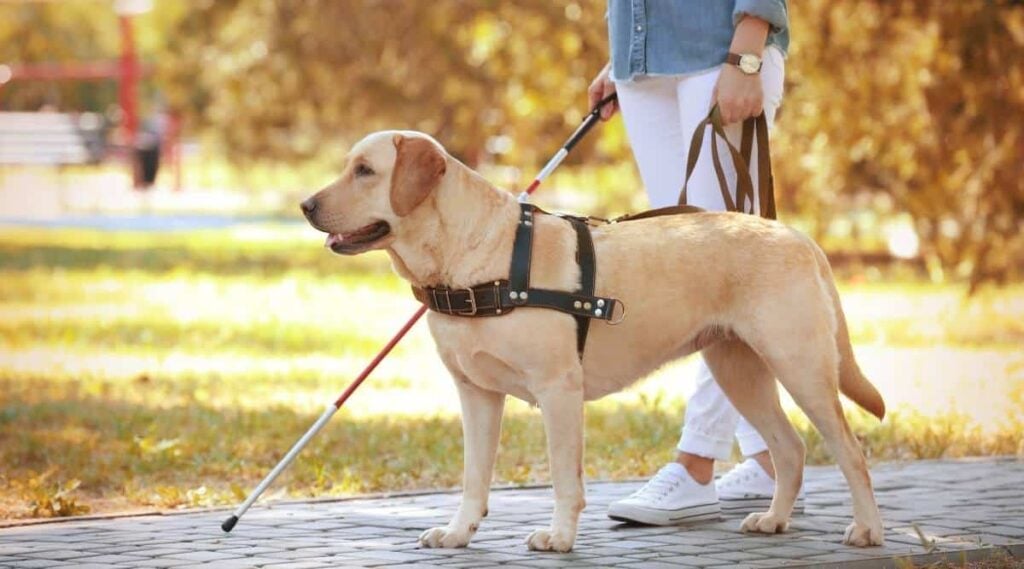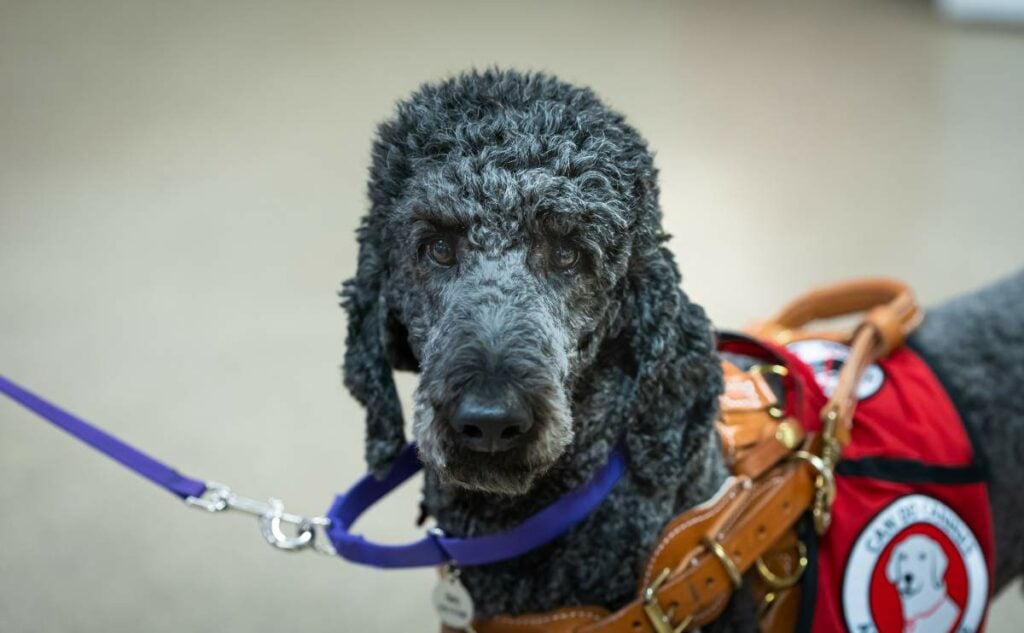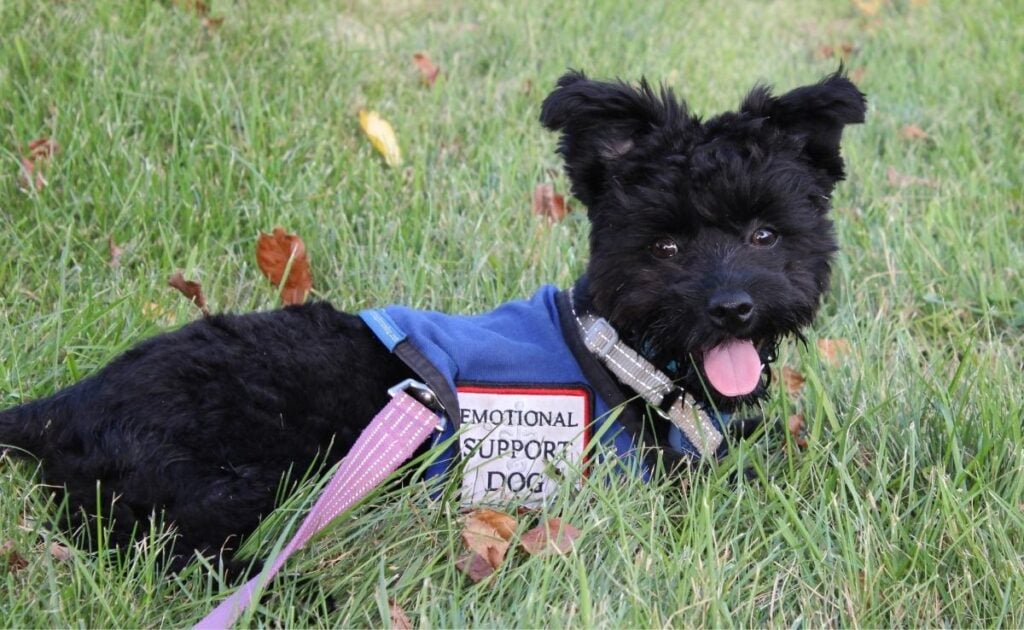STOP Confusing These Dogs! Service Dog vs. Therapy Dog vs. ESA Explained
When you purchase through links on our site, we may earn a commission. Here’s how it works.
If you’ve ever seen a dog wearing a harness or vest in public, you might have wondered: “Is that a service dog, a therapy dog, or an emotional support animal (ESA)?” Many people assume they’re interchangeable, but that couldn’t be further from the truth. While all three types of dogs provide support, they have very different jobs, training requirements, and legal rights. Only one of them has full public access under federal law, while the others have restrictions on where they can go.
Table of Contents

Unfortunately, confusion about these roles leads to misunderstandings, misplaced expectations, and even legal trouble. So, what sets a service dog apart from a therapy dog or ESA? What rights do each of these dogs have, and who qualifies for one? Let’s break it all down and clear up the confusion once and for all.
Understanding Support Dogs
Not all support dogs are the same, and assuming they are can lead to a lot of confusion. You’ve probably seen dogs in public with vests or harnesses and wondered, does that mean they’re allowed everywhere? Do they assist with medical needs or simply there for comfort? The truth is that service dogs, therapy dogs, and emotional support animals (ESAs) each have distinct roles, training requirements, and legal protections.
Misconceptions can lead to businesses denying access to legitimate service dogs or people mistakenly bringing ESAs into public places where they aren’t allowed. This guide will break down everything you need to know so that you can easily recognize the difference between service dogs, therapy dogs, and emotional support animals.
Service Dogs: Highly Trained Working Animals
Service dogs aren’t just well-behaved pets. They’re highly trained working animals that perform life-changing tasks for people with disabilities. Unlike emotional support animals or therapy dogs, service dogs do specific jobs that help their handlers navigate daily life. Whether it’s guiding a person who is blind, alerting someone with diabetes to a dangerous blood sugar drop, or even detecting seizures before they happen, these dogs are more than just companions. They are essential medical aids.

Because of their crucial role, service dogs have protection under the Americans with Disabilities Act (ADA). This means they have full public access rights. That’s why you’ll see them in restaurants, grocery stores, and even airplanes. The places where regular pets or emotional support animals aren’t allowed. Their job is to stay focused on their handler, which is why interrupting or petting a service dog without permission is a big no-no.
There are two main types of service dogs:
- Those that assist people with physical impairments (such as visually impaired or unable to perform certain tasks because of an illness or injury)
- Psychiatric service dogs help people with mental disabilities, such as anxiety, depression, post-traumatic stress disorder, etc.
Both types have the same legal rights, and they must always be on a leash, harnessed, or tethered (unless it interferes with the service animal’s work or the individual’s disability).
Our team look at the groundbreaking research that highlights the life-changing power of service dogs for veterans with PTSD.
Service Dog Training: How It Works
Service dogs undergo extensive training to ensure they can perform their duties without distraction. While professional organizations train some, others can be trained by their owners as long as they meet high behavioral and task-specific standards. The training process typically includes:
- Basic Obedience & Socialization. Service dogs must be calm, well-behaved, and comfortable in various environments. They learn commands like sit, stay, and heel to ensure they remain controlled in public places. They must also be housetrained.
- Task-Specific Training. Each service dog is trained to assist with a specific disability. Guide dogs for the blind learn directional commands, mobility assistance dogs help retrieve objects or open doors, and medical alert dogs detect conditions like seizures or low blood sugar.
- Public Access Training. Unlike therapy dogs or emotional support animals, service dogs must be trained to handle high-stress environments. These include busy streets, airports, and restaurants, without reacting to distractions.
Service dog training can typically take anywhere from six months to two years, depending on the complexity of the tasks they need to learn. While no official certification is required under federal law, a well-trained service dog must consistently perform their tasks reliably in real-world situations.
Service Dog Laws & Legal Rights
The ADA gives service dogs the right to accompany their handler anywhere the public is allowed. This includes restaurants, stores, public transportation, hotels, and even airplanes. Under the law:
- Businesses cannot ask for proof or certification of a service dog. They can only ask two questions: (1) Is the dog required due to a disability? (2) What task is the dog trained to perform?
- Service dogs are not considered pets. Service dogs must be permitted even in places with “no pets allowed” policies.
- The Fair Housing Act (FHA) protects service dogs in housing. Landlords cannot charge pet fees for service dogs, and they must allow them, even in no-pet housing.
Airports are an exception to standard service dog regulations. The TSA is federally authorized to require a U.S. Department of Transportation (DOT) form verifying the dog’s health, training, and behavior. For flights longer than eight hours, they may also request an additional form confirming that the dog can refrain from relieving themself during the flight. Fortunately, all commercial airports are legally required to provide a post-security Service Animal Relief Area (SARA) to accommodate service dogs.
Simply having a disability isn’t reason enough to categorize your own dog as a service dog. Your service dog must be able to complete tasks you cannot complete yourself. And remember, pretending to be disabled to gain access to an area is against the law.
Document Training
Service dog registration is not required by the ADA. If you have a psychiatric service dog, a doctor’s note may be required for airline travel and other public areas.
However, keeping document training dates and accomplishments in a notebook or online document can be helpful. Not only will this help you through training, but it will also provide a paper trail for your service dog. Having a professional training certificate or video recording can offer validity and put your mind at ease if your service dog certification is challenged. But it is not required.
What Not To Do Around Service Dogs
A working service dog is always on duty, even if they look relaxed. Unfortunately, many people make the mistake of treating service dogs like pets, which can distract them from their life-saving tasks. Here’s what you should NEVER do when you see a service dog:
- Pet Or Talk To Them. Even if they’re adorable, petting a service dog can distract them from their job. Always ask the handler first.
- Feed Them Treats Or Food. Service dogs follow strict training routines, and giving them food could interfere with their behavior.
- Assume They Are Off-Duty If They’re Resting. Service dogs may lie down or appear calm, but they are always alert and ready to assist their handler.
- Ask Invasive Questions. Many handlers don’t want to discuss their medical conditions. Respect their privacy, and don’t ask why they have a service dog.
By following proper service dog etiquette, you can ensure that these highly trained animals can focus on their job without unnecessary distractions. The news story below has some more tips based on a man’s experience with a service dog.
Therapy Dogs: Comfort & Emotional Support In Public Spaces
Unlike service dogs, which perform specific tasks for individuals with disabilities, therapy dogs provide comfort, emotional support, and companionship. You’ll often find them in hospitals, schools, nursing homes, and disaster relief areas. They help reduce stress, ease anxiety, and bring a sense of calm to those in need. These dogs don’t always assist just one person, they can serve entire communities by offering affection and emotional connection to those going through difficult times.
Therapy dogs come in all breeds and sizes. But they must have a calm temperament, a friendly personality, and the ability to remain composed in crowded or unpredictable environments. While they require some training to ensure good behavior in public spaces, therapy dogs are not considered service animals under ADA. This means they do not have the same legal protections and cannot access public places like restaurants, stores, or airplanes unless specifically invited.
Therapy Dog Training: What It Takes
While therapy dogs don’t need the same level of specialized training as service dogs, they must be well-behaved, social, and comfortable around people. Their training focuses on:
- Basic Obedience. Therapy dogs must know commands like sit, stay, down, and come. They should remain calm and under control in busy environments.
- Socialization & Temperament Testing. They need to be comfortable around strangers, other animals, loud noises, and medical equipment like wheelchairs or hospital beds.
- Handling Stressful Situations. Therapy dogs must not react negatively to sudden movements, unexpected touches, or new environments. They should be gentle and non-reactive, especially in high-stress areas like hospitals or schools.
Once a dog is trained and meets temperament requirements, they can undergo therapy dog certification. While certification isn’t legally required, many hospitals, schools, and therapy programs only accept registered therapy dogs that meet specific behavioral and vaccination standards. I have found the best therpay dog in training vest that is a valuable piece of gear during training sessions.
How To Certify A Therapy Dog
Although there is no federal certification for therapy dogs, many organizations provide structured training programs and testing to ensure dogs are ready to work in therapy settings. The process usually involves:
- Evaluating the Dog’s Temperament. A certified evaluator assesses whether the dog is friendly, calm, and adaptable in various environments.
- Passing a Therapy Dog Test. Dogs are tested on obedience, socialization, and their ability to handle unpredictable situations, such as being touched by multiple people at once.
- Completing a Therapy Dog Training Course. Some organizations require handlers to take a course on proper therapy dog etiquette, health requirements, and safety protocols.
- Registering with a Recognized Therapy Dog Organization. Many facilities require dogs to be certified by groups like Alliance of Therapy Dogs, Pet Partners, or Therapy Dogs International.
Therapy dog certification can be achieved through various organizations, but we recommend the AKC. To earn the AKC Therapy Dog title, you and your dog must do the following:
- Be certified by a therapy dog organization that is recognized by the AKC
- Perform the required number of visits:
- AKC Therapy Dog Distinguished (THDD) – 400 visits
- AKC Therapy Dog Excellent (THDX) – 200 visits
- AKC Therapy Dog Advanced (THDA) – 100 visits
- AKC Therapy Dog (THD) – 50 visits
- AKC Therapy Dog Novice (THDN) – 10 visits
- A therapy dog must be registered with AKC (both purebred and mixed breed dogs are eligible)
While therapy dogs don’t have legal public access rights, being certified increases their credibility and allows them to participate in official therapy programs, hospital visits, and school-based emotional support initiatives.
Where Are Therapy Dogs Used?
Therapy dogs play a crucial role in improving mental and emotional well-being across various settings:
- Hospitals & Nursing Homes. Therapy dogs visit patients to lift spirits, reduce anxiety, and provide companionship to those undergoing medical treatments.
- Schools & Universities. Many colleges now use therapy dogs during exam seasons to help students reduce stress and improve mental focus.
- Disaster Relief & Crisis Response. Therapy dogs are often deployed to comfort survivors of natural disasters, mass tragedies, or other traumatic events.
- Rehabilitation & Counseling Centers. Therapy dogs assist individuals in therapy programs, particularly those recovering from PTSD, anxiety, or depression.
While these dogs provide tremendous emotional benefits, it’s important to remember that therapy dogs are not service animals. They do not have legal access to public spaces unless invited as part of a therapy program.
Emotional Support Animals (ESAs): Companionship & Mental Health Benefits
Emotional Support Animals (ESAs) are often misunderstood, and for good reason. They don’t fit neatly into the same category as service dogs or therapy dogs. While they provide comfort and companionship to individuals with mental or emotional health conditions, they do not require specialized training and do not have public access rights like service dogs.

But that doesn’t mean they aren’t important. For people struggling with anxiety, depression, PTSD, or other mental health challenges, an ESA can be a life-changing source of emotional stability and support. Unlike service dogs, which are trained to perform specific tasks, ESAs don’t have to do anything other than provide comfort, emotional reassurance, and a calming presence.
They aren’t required to undergo public access training or specialized obedience courses, and any domesticated animal, dogs, cats, even rabbits, can qualify as an ESA. However, just because an ESA doesn’t need extensive training doesn’t mean they don’t play a crucial role in their owner’s well-being.
ESA vs. Service Dog: What’s The Difference?
One of the biggest misconceptions about ESAs is that they have the same legal protections as service dogs. They don’t.
- Service Dogs are protected under the ADA and can go anywhere their handler goes, including restaurants, stores, and public transportation. They are trained to perform tasks related to a disability, such as guiding the visually impaired or alerting to medical conditions.
- Emotional Support Animals are not considered service animals under the ADA. They do not have public access rights and cannot enter businesses, restaurants, or public spaces that don’t allow pets. Their only legal protections apply to housing and, in limited cases, air travel.
This means you can’t bring an ESA into a coffee shop, hotel, or airplane cabin just because you have an ESA letter. Many people mistakenly believe they can, which has led to controversy and increased restrictions around ESAs in public spaces.
ESA Laws & Rights: What You Need To Know
While ESAs don’t have the same rights as service dogs, they are still protected under specific federal laws:
- Fair Housing Act (FHA). Landlords cannot refuse housing to individuals with an ESA, even if the property has a “no pets” policy. They also cannot charge pet fees or breed restrictions for ESAs. However, landlords may request a legitimate ESA letter from a licensed mental health professional to verify the need for the animal.
- Air Carrier Access Act (ACAA). In the past, ESAs were allowed to fly in airplane cabins with their owners. However, due to increased fraud and abuse of ESA rules, most major airlines no longer recognize ESAs as service animals. Instead, they are now treated as regular pets, requiring pet fees and travel restrictions.
These changing rules have led to a lot of confusion and frustration for ESA owners. In December 2020, the U.S. Department Of Transportation (DOT) announced it no longer considers ESAs a special assistance animal for air travel. As a result, it’s now up to the airlines to set their own ESA policies. Most major U.S. carriers are following the DOT guidelines and only allow trained service animals:
- Alaska – As of January 11, 2021, Alaska only accepts trained service dogs.
- American Airlines – As of January 11, 2021, travel for ESAs is no longer authorized.
- Delta – ESA reservations submitted and confirmed before January 11, 2021, are accepted. But, they no longer book new ESA reservations.
- Southwest – As of March 1, 2021, Southwest only accepts trained service dogs.
- Spirit – As of January 11, 2021, ESAs can travel onboard as pets only.
- United – Will honor ESAs for reservations purchased before January 11, 2021, for travel on or before February 28, 2021. After February 28, 2021, they will no longer allow ESAs.
Pets (including ESAs) that meet an airline’s specific requirements may travel with you or in cargo but are subject to paperwork and fees. We have a comprehensive guide about flying with dogs for more information.
Characteristics To Look For In An ESA
Since ESAs don’t require formal training, choosing the right dog (or other pet) is crucial. The best ESAs tend to be:
- Affectionate & People-Oriented. They should seek out human interaction and enjoy being close to their owner.
- Calm & Low-Reactive. An ESA shouldn’t be overly anxious, aggressive, or easily startled.
- Adaptable To Different Environments. Since ESAs provide comfort at home and in social settings, they should be comfortable with new places and people.
- Responsive To Their Owner’s Emotions. The best ESAs can sense stress, sadness, or anxiety and react by offering comfort.
If you’re considering getting an ESA, it’s important to choose an animal with a natural ability to provide emotional support rather than just picking a pet you like. We have an informative guide that dives deeper into emotional support animals.
If you’re looking to register your ESA, we have a guide on legitimate emotional support animal registration. Our team have also reviewed CertaPet, taking you through the ESA letter process, the costs, personal experiences, and more.
Choosing The Right Support Dog For Your Needs
Not all support dogs are created equal, and picking the wrong one for your situation can lead to frustration for both you and the dog. Whether you need a service dog, therapy dog, or emotional support animal (ESA), it’s important to choose a dog that fits your lifestyle, needs, and level of commitment.

The first step is understanding exactly what you need the dog for. If you have a disability and require assistance with daily tasks, a service dog is the right choice. Perhaps you want to volunteer in hospitals, schools, or nursing homes to spread comfort and joy; a therapy dog is a great option. If you struggle with anxiety, PTSD, or other mental health conditions and need emotional companionship at home, an ESA might be your best match. Each type of support dog has different requirements, and knowing the difference will help you make the right decision.
What’s Your Lifestyle? Picking A Dog That Fits
Once you’ve determined what type of support dog you need, the next step is finding a dog that matches your daily routine, home environment, and personality. Ask yourself these questions:
- Do you have an active lifestyle? If so, a high-energy breed like a Labrador Retriever or Border Collie might be the perfect fit for service work. These breeds thrive on physical activity and mental stimulation.
- Do you live in an apartment or a small space? Smaller breeds like Cavalier King Charles Spaniels or French Bulldogs make great ESAs because they don’t need a large yard to stay happy.
- Do you have allergies? Hypoallergenic breeds like Poodles and Goldendoodles are great options for people who need a service dog or ESA but struggle with pet dander.
- Do you need a dog that’s calm and adaptable? Therapy dogs and ESAs must be naturally social and non-reactive to loud noises, strangers, and unpredictable environments. Breeds like Golden Retrievers and Newfoundlands tend to be incredibly patient and gentle.
A great support dog isn’t just about breed. It’s about temperament and personality. Some dogs are naturally suited for service or emotional support, while others might not have the right disposition. That’s why proper training and evaluation are essential.
Best Dog Breeds For Service Work
Not all dogs are suited for service work. A great service dog needs to be highly intelligent, trainable, calm under pressure, and physically capable of performing the required tasks. While many breeds can be trained for service roles, certain breeds are naturally better suited due to their temperament, size, and ability to focus on their handler. Some of the most commonly used service dog breeds include:
- Labrador Retrievers – Smart, friendly, and eager to please, Labradors are among the most popular service dog breeds.
- Golden Retrievers – Gentle, patient, and highly intuitive, Golden Retrievers excel at both physical assistance and emotional support.
- Standard Poodles – Intelligent, hypoallergenic, and highly trainable. Standard Poodles are excellent for individuals with allergies who need a service dog.
- German Shepherds – Known for their loyalty and strong work ethic, German Shepherds are often used as guide dogs, mobility assistance dogs, and PTSD service dogs.
- Border Collies – Extremely intelligent and eager to work, Border Collies are well-suited for medical alert services and psychiatric support.
While these breeds are commonly chosen for service work, any dog with the right temperament, intelligence, and physical ability can be trained to be a service dog. The key is selecting a dog that matches the handler’s needs and lifestyle. Service dogs must be highly focused, adaptable, and capable of handling stressful environments without becoming distracted.
Best Dog Breeds For Therapy Work
Not every dog is suited for therapy work. A great therapy dog needs to be friendly, social, calm under pressure, and adaptable to different environments. Since therapy dogs provide comfort and emotional support in hospitals, schools, nursing homes, and disaster relief areas, they must be non-reactive to loud noises, strangers, and unexpected interactions. While almost any dog with the right temperament can become a therapy dog, some breeds naturally excel in this role.
- Golden Retrievers – Gentle, affectionate, patient, and highly social. Golden Retrievers are one of the best therapy dog breeds.
- Labrador Retrievers – Friendly, adaptable, and eager to please. Labradors are commonly used in schools, counseling centers, and rehabilitation programs.
- Cavalier King Charles Spaniels – Small, affectionate, and incredibly gentle. Cavaliers are ideal for therapy work in nursing homes and hospitals.
- Bernese Mountain Dogs – Large but incredibly gentle. Bernese Mountain Dogs have a calm, affectionate temperament that makes them excellent for stress relief in schools, hospitals, and crisis response settings.
- Poodles & Doodles – Highly intelligent and hypoallergenic. Standard and Miniature Poodles (as well as Goldendoodles and Labradoodles) are excellent therapy dogs. Their calm demeanor, non-shedding coats, and adaptability make them an excellent choice for therapy work in public spaces.
- Newfoundlands – Known as “gentle giants,” Newfoundlands have a calm, steady nature. This makes them ideal for comforting patients in hospitals and providing emotional support in crisis situations.

While these breeds are commonly used for therapy work, any dog with a calm, affectionate personality and a love for people can become a therapy dog with proper training. The key is selecting a dog that is well-socialized, adaptable, and comfortable in various environments.
Best Dog Breeds For Emotional Support Animals
Not all dogs are suit emotional support roles. The best ESAs are calm, affectionate, and naturally in tune with their owner’s emotions. Some of the most popular ESA breeds include:
- Labrador Retrievers – Friendly, affectionate, and excellent companions for anxiety and PTSD support.
- Golden Retrievers – Gentle and highly intuitive, making them great for emotional stability.
- Cavalier King Charles Spaniels – Small, cuddly, and affectionate, perfect for apartment living.
- Poodles & Doodles – Hypoallergenic and highly intelligent, great for owners with allergies.
- French Bulldogs – Loyal, low-energy, and great for stress relief.
While these breeds are known for their emotional intelligence, any dog with the right temperament can be an ESA. The key is choosing a dog that matches your lifestyle and emotional needs.
Key Differences: Therapy Dog vs Service Dog vs Emotional Support Dog
To recap, let’s look at the difference between service, therapy & emotional support dogs:
- A service dog is certified and trained to help people with disabilities, such as visual impairments, mental illnesses, seizure disorders, diabetes, etc.
- A therapy dog is trained to provide comfort and affection to people in hospice, disaster areas, retirement homes, hospitals, nursing homes, schools, and more.
- An emotional support animal (ESA) provides their owners with therapeutic benefits through companionship. They do not require training, but you may be screened by a mental health professional to see if you qualify.
What Kind Of Dog Is Needed?
I thought it’d be fun to “quiz” you to see if you can distinguish which type of dog is appropriate for various scenarios. Test your knowledge below.
Q: What kind of dog helps a person when they need assistance with a disability while flying?
A: Service dog
Q: What kind of dog is needed at school to help children experiencing anxiety?
A: Therapy dog
Q: What kind of dog can pull a wheelchair?
A: Service dog
Q: What kind of dog offers companionship in day-to-day activities for one person?
A: Emotional support dog
Q: What kind of dog can protect someone who is having a seizure?
A: Service dog
Q: What kind of dog is needed to remind a person with mental illness to take their prescription?
A: Service dog
Q: What dog helps a person with autism?
A: Service dog
Q: What kind of dog works with numerous people?
A: Therapy dog
Q: What kind of dog calms a person with Post Traumatic Stress Disorder (PTSD)?
A: Service dog
Additional Support For Training Dogs
We hope this article sheds some light on the differences between service, therapy, and emotional support animals. We know it can be confusing, but it’s important to understand that there are various laws, certifications, and guidelines that each should adhere to. If you want to teach your dog to become one of these dogs, I recommend starting first with some basic obedience training, which you can do at home or virtually. Learn more about online dog training options. We have found the best dog training apps for dog training on the go, too. If you’re unsure whether to send your dog to board training school or to train them at home, we compare the best option for you and your pup.
Do you have any questions about therapy vs ESA vs service dogs still? We love to hear from our readers. So, if you have one of these incredible pups, share your stories with us in the comments below.
Why Trust Canine Journal
Kimberly has written about various dog-related topics, such as pet insurance, health conditions, treats, training, and more. She consulted with other Canine Journal members to glean their personal experiences and knowledge about support dogs. Kimberly spent over 10 hours researching and writing this article. She works with a dedicated team to ensure Canine Journal remains a trusted and go-to online resource for all things dog.



